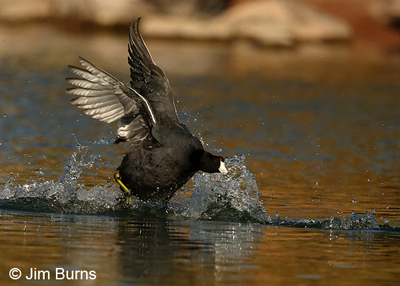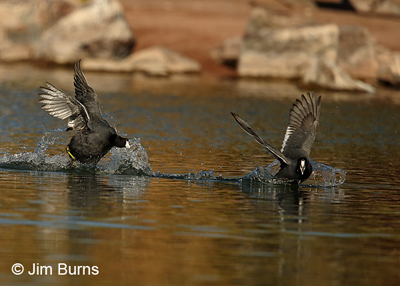
I showed this photo to my favorite birder and asked her “What’s wrong with this picture?” The long pause which ensued told me I was right in thinking the image presented a bit of a riddle. The bird is obviously an American Coot, no mystery there, but something about the picture is a little odd. Can you discern what it is?
Let’s start by figuring out what this coot is doing. I’m guessing a lot of birders don’t pay much attention to coot behavior because the species is so common and so easily identified. Coots don’t get a lot of love. Though many non-birders dismiss them as ducks, coots are neither as beautiful nor as graceful in the air or on water as the ducks with which they associate. If you’ve ever watched an American Coot try to walk on land or lift off the water, you may well feel comedic relief provided by these two endeavors is the only reason for even looking at them.
Furthermore, here’s what Birds of North America has to say about the species under its Agonistic Behavior heading: “Universally described as a quarrelsome and belligerent bird, more than ready, willing, and able to engage in either ritualized or outright physical conflict with its own or other avian species.” This translates, especially during breeding season, into countless coot negotiations over territorial boundaries—coot face-offs, coot chases, and actual coot fights which can, make no mistake, occasionally end in the death of one of the combatants.
The majority of these disputes end with the trespasser being chased off by the more aggressive holder of the territory. These chases give birders frequent opportunity to observe eye and ear catching American Coot behavior known as “splattering,” in which both the trespasser and the aggressor run on top of the water, wings flapping for balance and directional control. When the chasee outdistances its pursuer and dives beneath the surface, the latter breaks off the chase.
On those occasions when neither bird backs away from a face-off, both lean back and begin raking one another’s breasts with their claws, sometimes becoming entangled and then trying to strike with their bills. The weaker bird will be forced underwater and held there until it is able to disengage and swim away. These fights are loud and sometimes lethal. You can view a fight sequence at jimburnsphotos.com/pages/americancoot.html .
The opening image of a coot “running on water” seems odd because there is splatter both behind and in front of the bird. How is this physically possible? If you consider the entire agonistic sequence, it becomes obvious this coot is the chaser, the splatters in front of it are from the chasee ahead of it, and the inept cameraman, that would be me, failed to catch both combatants in the same frame. As you can see in the closing photo, I did better in the next frame by zooming out.
There are two things to be learned from this photo quiz. The camera can’t always capture the whole story and, though common and unattractive, coots can be an interesting species to observe for birders with patience.